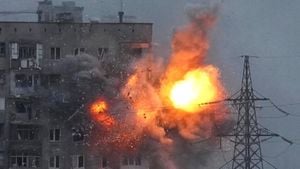Pakistan's Kurram district is once again the center of intense and tragic sectarian violence, with more than 80 lives lost and over 150 injured following the latest clashes. This recent surge of hostility, which erupted on November 23, when assailants ambushed Shiite Muslim convoys, has laid bare the long-standing sectarian tensions and tribal rivalries embedded deeply within this region bordering Afghanistan.
An uneasy ceasefire was established shortly after through negotiations involving local Shiite and Sunni leaders, yet the fragility of this truce reveals just how precariously balanced peace is amid simmering hostilities. Muhammad Ali Saif, the Khyber Pakhtunkhwa province spokesman, announced the seven-day ceasefire agreement as an urgent necessity to alleviate tensions escalated by retaliatory violence. Survivors from the ambush have shared horrifying accounts of their experiences, with one woman, Saeeda Bano, recounting how she hid beneath car seats praying for her life.
Such traumatic experiences are common for many residents of Kurram, with sectarian violence and tribal clashes posing persistent threats. This time, the sectarian clashes have led to curfews and suspensions of mobile services, restricting communication and movement among local populations. The civil order has deteriorated to the point where even peace negotiations are met with violence; authorities reported their helicopter being shot at during arrival, illustrating the deep-seated animosity and volatility.
The Kurram district is characterized by its diverse religious demographics, with Shiites making up around 15% of Pakistan’s population. The region’s religious composition includes both Shiite and Sunni communities; this diversity has historically led to tension, particularly around land disputes. Over recent months, the district has seen more than 60 deaths attributed to sectarian violence, highlighting the urgent need for systemic changes.
Despite potential pathways to long-term stability, the Pakistani government has struggled to provide effective solutions to reoccurring sectarian conflict. Local tribal councils and authorities have initiated talks, but the effectiveness of these efforts has yet to materialize, leaving many residents feeling unprotected. Local leaders have called for lasting peace, recognizing the need to address foundational issues fueling these violent outbursts more vigorously.
Statistically, Kurram's violence is part of broader cycles of conflict experienced regionally. The area has seen similar humanitarian crises multiple times, with about 150 fatalities reported just this year alone. While government representatives have engaged tribal leaders for negotiations, there remains significant frustration about the lack of immediate and applicable solutions to keep tensions low.
The scope of the sectarian divide is not just confined to religious differences but extends to issues such as land ownership—a factor deeply tangled with tribal identities. The Bangash and Turi tribes, predominantly Shiite, have periodically clashed with other tribal communities over ownership of agricultural land. This historical feud continues to exacerbate existing tensions, fueling community polarization and highlighting the need for thorough mediation.
Calls for action have become more pronounced as demonstrated by large protests conducted by local communities demanding government attention to their safety and rights. Their cry for assistance underlines not only the emotional toll of violence but urgent legislative measures needed to prevent future occurrences.
The Pakistani state must address policies relating to land ownership and the management of inter-tribal relations, which are often exploited by extremist groups aiming to incite sectarian strife. Recent reports suggest the emergence of connections between civilian disputes and targeted sectarian violence orchestrated by such groups, intensifying the complexity of the sociopolitical fabric.
While the interim ceasefire is viewed as necessary, the notion of reverting to previous ceasefire arrangements without addressing the underlying instabilities renders future agreements hollow. This situation creates skepticism among citizens watching their communities bear the brunt of bloodshed fueled by sectarianism and negligence.
Political analysts argue for the need for genuine dedication from both the state and community leaders in crafting solutions pond to encourage mutual respect and coexistence. Regional governance mechanisms could potentially involve higher degrees of autonomy for local representatives, allowing more effective conflict resolution.
The challenge lies not just in ceasefires, but also how leaders of different sects can be first to work together to lay the foundational groundwork needed for inter-community trust and resource sharing. The road to lasting peace hinges on both recognition of shared grievances and actionable steps to transform conflict dynamics.
This complexity is compounded by the role of the Pakistan military, which has historically backed Sunni extremist factions ostensibly to maintain some control over the area. Such backing has led many Shia groups to feel increasingly isolated, raising worries among them about the future of their community.
Given the long-standing nature of these conflicts and their deeply ingrained roots, resolving the tensions may take time and requires both negotiations and trust-building between the parties involved. Although recent negotiations show promise, the sustainability of peace hinges on addressing the core issues—security, governance, land disputes, and unity among sects—that drive these violent outbreaks.
For Kurram residents, the emphasis on systemic change and accountability within the government holds the key to securing humanitarian outcomes. What they desire is not only immediate safety but also the right to return to normalcy—a hope for peace—essential for forging renewed communal relations and rebuilding the war-torn societal structures.



